Healing for Post-Radiation Injuries in Fargo, ND
Radiation may be over, but the side effects don’t always end when treatment does.
Post-radiation injuries, also known as delayed radiation injuries, can develop slowly—causing tissue damage, pain, or chronic symptoms that appear months or even years after cancer treatment. These injuries often go unrecognized or untreated, leaving patients with unresolved complications and few options.
Whether you’re a patient living with these side effects or a loved one of someone struggling post-cancer, our goal is to offer clarity, comfort, and a path to true healing.
At Healing with Hyperbarics in Fargo, ND, we use hyperbaric oxygen therapy (HBO therapy) to treat post-radiation injuries at the root—restoring oxygen-deprived tissue, reducing inflammation, and helping you feel like yourself again.
What Are Delayed Radiation Injuries?
Delayed radiation injuries—also known as post-radiation tissue damage—occur when healthy tissue is damaged as a side effect of past radiation therapy. These effects can surface months or even years after cancer treatment ends, often catching patients off guard with a sudden onset of symptoms.
Radiation doesn’t just target cancer cells—it can also affect surrounding healthy tissue. Over time, reduced blood flow, tissue breakdown, and oxygen deprivation can lead to pain, wounds, and functional decline in the treated area.
Radiation damage doesn’t always show up right away. For many people, symptoms of delayed radiation tissue injury appear months or even years after completing cancer treatment. These injuries can affect soft tissue, skin, and even bone—especially in areas that received high-dose radiation, such as the jaw, pelvis, or chest.
Many people don’t realize their symptoms are linked to radiation. Some are misdiagnosed, while others are told nothing more can be done. But there is hope, especially when treatment targets the root cause: oxygen-starved, damaged tissue.
Common Symptoms of Post-Radiation Injuries
Signs & Symptoms of Post-Radiation Injuries
If you or a loved one are experiencing any of the following symptoms after radiation, it may be a sign of a post-radiation injury:
• Chronic pain, tightness, or swelling in the area of past radiation
• Difficulty swallowing or speaking (after head, neck, or throat radiation)
• Open wounds or slow-healing surgical sites
• Exposed or infected bone (common with jaw radiation)
• Fatigue, weakness, or loss of function in a previously radiated area
• Unexplained tissue breakdown or recurring infections
These symptoms often stem from reduced blood flow, inflammation, and tissue hypoxia (lack of oxygen) caused by radiation exposure. Unfortunately, they’re also often overlooked or dismissed as unrelated side effects.
Why Hyperbaric Oxygen Therapy Works for Post-Radiation Injuries
Radiation damage doesn’t heal like other injuries.
When healthy tissue is exposed to radiation, it can become chronically inflamed, oxygen-starved, and unable to repair itself—sometimes years after cancer treatment ends. Unlike medications or topical wound care, hyperbaric oxygen therapy (HBO therapy) works at the root level by restoring oxygen, reversing tissue damage, and jumpstarting the body’s natural healing process.
What HBO Therapy Does
Delivers 100% oxygen at higher-than-normal pressure to increase oxygen in blood plasma
Stimulates new blood vessel growth (angiogenesis) in damaged areas
Reduces chronic inflammation and improves circulation
Boosts immune response and collagen production
Speeds recovery time for wounds, infections, and bone/tissue breakdown
The result: Long-term tissue repair—not just symptom relief.
Types of Post-Radiation Injuries We Treat
Radiation therapy can affect any area of the body that receives high-dose treatment. At Healing with Hyperbarics, we use hyperbaric oxygen therapy to treat a wide range of post-radiation injuries, including:
-
Radiation can damage healthy tissue in the treatment area, leading to long-term complications that may not appear for months or even years. This type of radiation tissue damage is most common after breast, prostate, pelvic, or abdominal cancer treatment.
It often results in chronic inflammation, pain, fibrosis (hardening of tissue), and reduced blood flow, making the area vulnerable to non-healing wounds or ulcers. Hyperbaric oxygen therapy delivers high levels of oxygen to the damaged tissue, stimulating healing at the cellular level. -
When radiation affects the bladder or rectum (often following prostate, bladder, or cervical cancer treatment) patients may develop radiation cystitis or radiation proctitis.
These conditions can cause pain, burning, incontinence, frequent urination, rectal bleeding, and urgent bowel movements. These symptoms stem from inflammation and blood vessel damage, which can worsen without treatment. HBO therapy improves circulation, reduces bleeding, and encourages new tissue growth, offering long-term relief from symptoms. -
One of the most serious head and neck radiation complications, osteoradionecrosis, occurs when the jawbone begins to deteriorate due to lack of oxygen and blood flow.
This condition can develop months (or even years) after radiation for oral, throat, or laryngeal cancers. Common signs include exposed jaw bone, pain, difficulty chewing or speaking, and non-healing dental extractions.
HBO therapy is a proven, FDA-approved treatment that helps treat this damage by stimulating blood vessel regrowth and bone healing. It’s often prescribed before or after dental surgery to prevent or treat osteoradionecrosis. -
Radiation can impair the body’s natural healing response, especially at surgical sites or in skin folds. This results in wounds that reopen, remain inflamed, or fail to close long after surgery or cancer treatment.
These wounds are often misdiagnosed or treated with standard wound care, despite their oxygen-starved, radiation-damaged nature. HBO therapy accelerates healing by addressing the root cause (oxygen deprivation) and supporting collagen production and tissue repair.
These injuries often have one thing in common: the tissue is oxygen-deprived and unable to heal. That’s where hyperbaric oxygen therapy comes in.
How HBO Therapy Works at Healing with Hyperbarics
At Healing with Hyperbarics, we follow evidence-based, FDA-approved treatment protocols for delayed radiation injuries—grounded in decades of medical research and proven outcomes. These standardized approaches ensure patients receive the most effective care possible for soft tissue and bone damage caused by radiation, all under the guidance of our experienced, physician-led team.
What to Expect with HBOT
-
Step 1: Consultation
Meet with our physician to determine if HBO therapy is right for your post-radiation injury and get a personalized treatment plan.
-
Step 2: Treatment Sessions
Each treatment lasts 2 hours in a spacious, clear-acrylic hyperbaric chamber. Most patients relax, nap, or watch TV during treatment.
-
Step 3: Ongoing Evaluation
We monitor healing progress closely and adjust your treatment plan as needed. Most post-radiation treatment plans include 20–40 sessions, depending on the severity and location of injury.
Is Hyperbaric Oxygen Therapy Covered by Insurance?
The short answer: Yes—most insurance plans do cover hyperbaric oxygen therapy (HBOT) for post-radiation injuries.
Because HBOT is FDA-approved for treating delayed radiation injuries, including soft tissue and bone damage from cancer treatment, it is typically covered by Medicare and most private insurance providers.
However, coverage details—such as co-pays, deductibles, and prior authorization—can vary by plan.
Our team will walk with you every step of the way—answering questions, managing insurance approvals, and ensuring you feel comfortable and confident in your care.
What We Handle for You
Insurance verification
Submitting prior authorizations (when needed)
Communicating with and updating referring providers on your progress
Ensuring you receive treatment promptly and with peace of mind
We’re here to help you every step of the way—from verifying benefits and obtaining prior authorization to submitting referrals and answering insurance questions. No referral is required to get started.
Hyperbaric oxygen therapy (HBOT) is covered by:
Medicare
TRICARE
Most private insurance providers*, including (but not limited to):
Blue Cross Blue Shield
Health Partners
Sanford Health Plan (note: not all Sanford plans cover HBOT)
Cigna Healthcare
Aetna
UnitedHealthcare
*Insurance plans vary. Please contact our office to confirm coverage and benefits under your specific plan. At this time, Medicaid is not accepted for hyperbaric oxygen therapy.
Insurance Coverage Details
Referring Providers: Partnering to Improve Post-Radiation Recovery
Healing with Hyperbarics partners with medical professionals across the Midwest to support patients experiencing delayed radiation injuries. We provide a streamlined referral process, transparent communication, and proven results.
Oncologists — For soft tissue damage, non-healing radiation wounds, or radiation necrosis
Oral & Maxillofacial Surgeons — For osteoradionecrosis of the jaw
Radiation Therapists — When symptoms emerge weeks, months, or years post-treatment
Primary Care Providers — For patients reporting unexplained pain, wounds, or functional decline, with a history of radiation
Wound Care Specialists — For patients not responding to standard therapies
Who Commonly Refers to Us
Why Providers Trust Healing with Hyperbarics
FDA-approved therapy and clear clinical protocols
Full care coordination—our team communicates directly with your clinic
Objective healing markers and follow-up reporting
Medicare and insurance coverage assistance
Whether you’re referring a patient or exploring HBO therapy as part of your post-cancer care protocols, we’re here to support your practice and patients every step of the way.
FAQs About Post-Radiation Hyperbaric Oxygen Therapy
If you’re searching for answers about hyperbaric oxygen therapy for post-radiation side effects, you’re not alone. Many patients and caregivers are navigating the long-term effects of cancer treatment—often years after completing radiation.
This FAQ section addresses the most common questions we receive at Healing with Hyperbarics, from how HBO therapy works to what symptoms it treats, insurance coverage, and what to expect during treatment. Whether you’re dealing with soft tissue damage, osteoradionecrosis, or unexplained post-radiation pain, we’re here to provide clarity and trusted answers rooted in clinical experience and results.
-
Hyperbaric oxygen therapy (HBO therapy) is a medical treatment where patients breathe 100% oxygen inside a pressurized chamber. This increases the amount of oxygen your blood can carry, supporting the body’s natural healing processes. HBO is painless, non-invasive, and FDA-approved for various conditions, including post-radiation injuries.
-
Yes. HBO therapy has been clinically proven to treat delayed or post-radiation injuries by:
Reducing inflammation
Restoring oxygen-starved tissue
Stimulating new blood vessel growth
Supporting soft tissue and bone regeneration
Patients with radiation damage to the bladder, bowel, jaw, or skin often experience reduced pain, improved healing, and restored function after completing treatment.
-
HBO therapy is FDA-approved and commonly used for delayed radiation injuries such as:
Radiation cystitis or radiation proctitis (bladder/bowel damage)
Non-healing post-radiation wounds
Radiation necrosis
Osteoradionecrosis of the jaw or skull
-
Yes. Hyperbaric oxygen therapy for delayed radiation injuries is FDA-approved and covered by:
Medicare
TRICARE
Most private insurance providers*, including (but not limited to):
Blue Cross Blue Shield
Health Partners
Sanford Health Plan (note: not all Sanford plans cover HBOT)
Cigna Healthcare
Aetna
UnitedHealthcare
*Please note: Medicaid does not currently cover HBO therapy. Our team will help you verify insurance coverage and handle all necessary paperwork. -
No referral is required to begin treatment at Healing with Hyperbarics. However, we frequently collaborate with oncologists, surgeons, and primary care providers to ensure comprehensive care.
To schedule a consultation, you can:
Call us at 701.532.2426
Email us at info@healingwithhyperbarics.com
Fill out the form on our Contact page
-
Delayed radiation injuries can appear weeks, months, or even years after cancer treatment. If you’re experiencing symptoms such as pain, non-healing wounds, or tissue damage, it’s not too late to begin healing.
Schedule a consultation to see if HBO therapy is right for you.
-
Treatment protocols vary depending on the injury and severity, but most patients undergo between 20–40 sessions for post-radiation recovery. Each session lasts 2 hours and is overseen by our trained clinical team.
-
Yes. HBO therapy is a non-invasive, FDA-approved treatment with a long track record of safety and success. Our clinic follows industry-leading protocols and research with Dr. Daphne Denham, a well-known hyperbaric physician, leading our team to ensure the highest level of care.
Start Healing From Radiation Damage
If you or a loved one are living with delayed radiation injuries, you don’t have to manage the symptoms alone. Healing is possible—and it starts here.
At Healing with Hyperbarics, we offer:
Physician-led hyperbaric oxygen therapy
Personalized treatment plans
Insurance-covered care for most radiation-related conditions
Compassionate, experienced staff ready to guide you every step of the way
We’re here to answer your questions, walk you through your options, and help you reclaim quality of life—no referral required.





